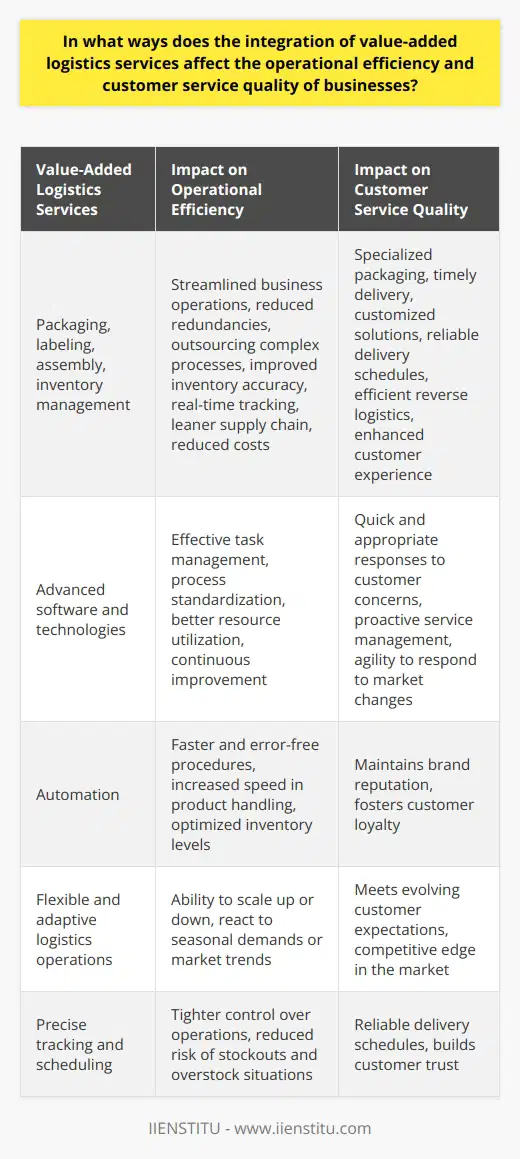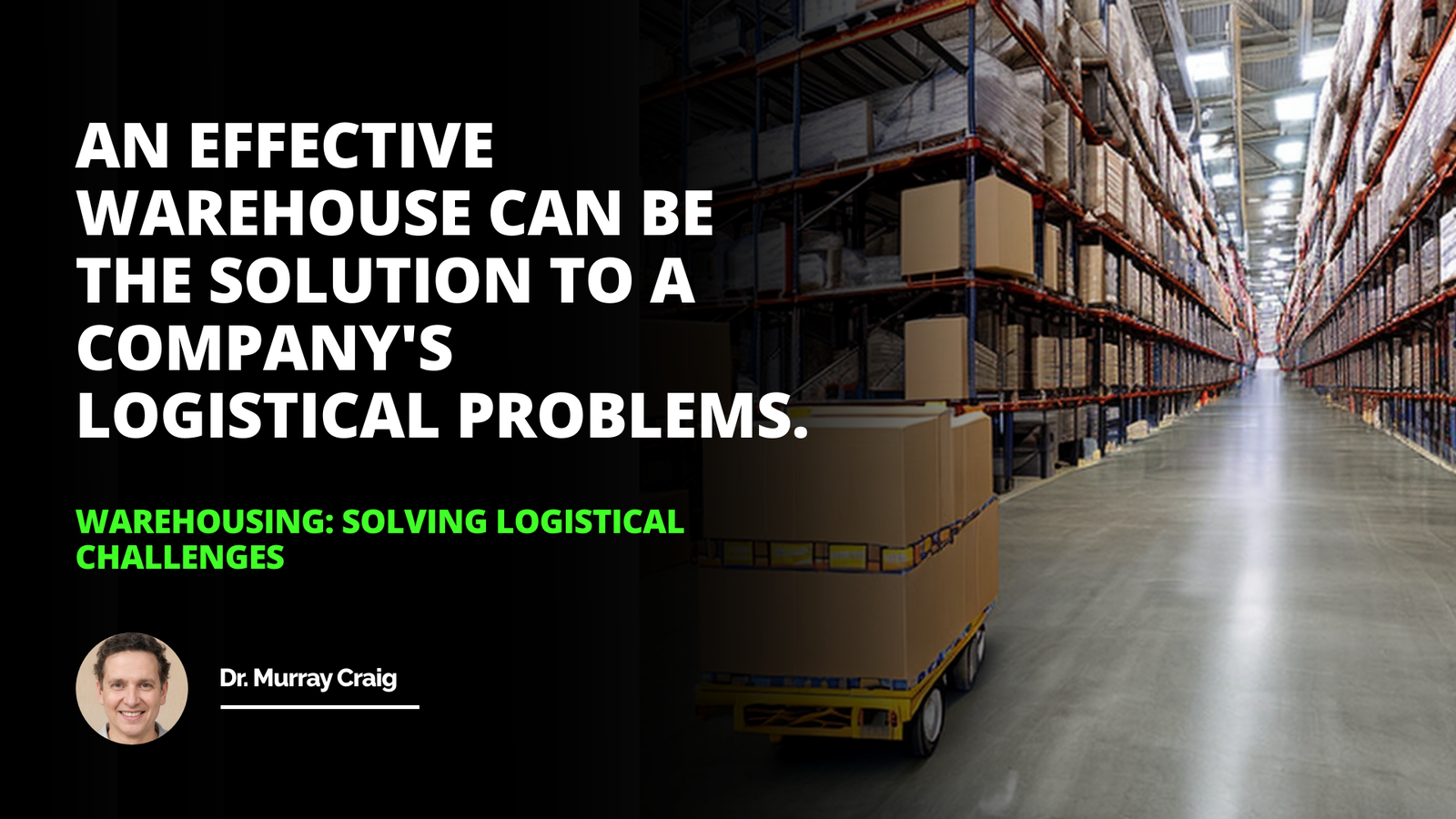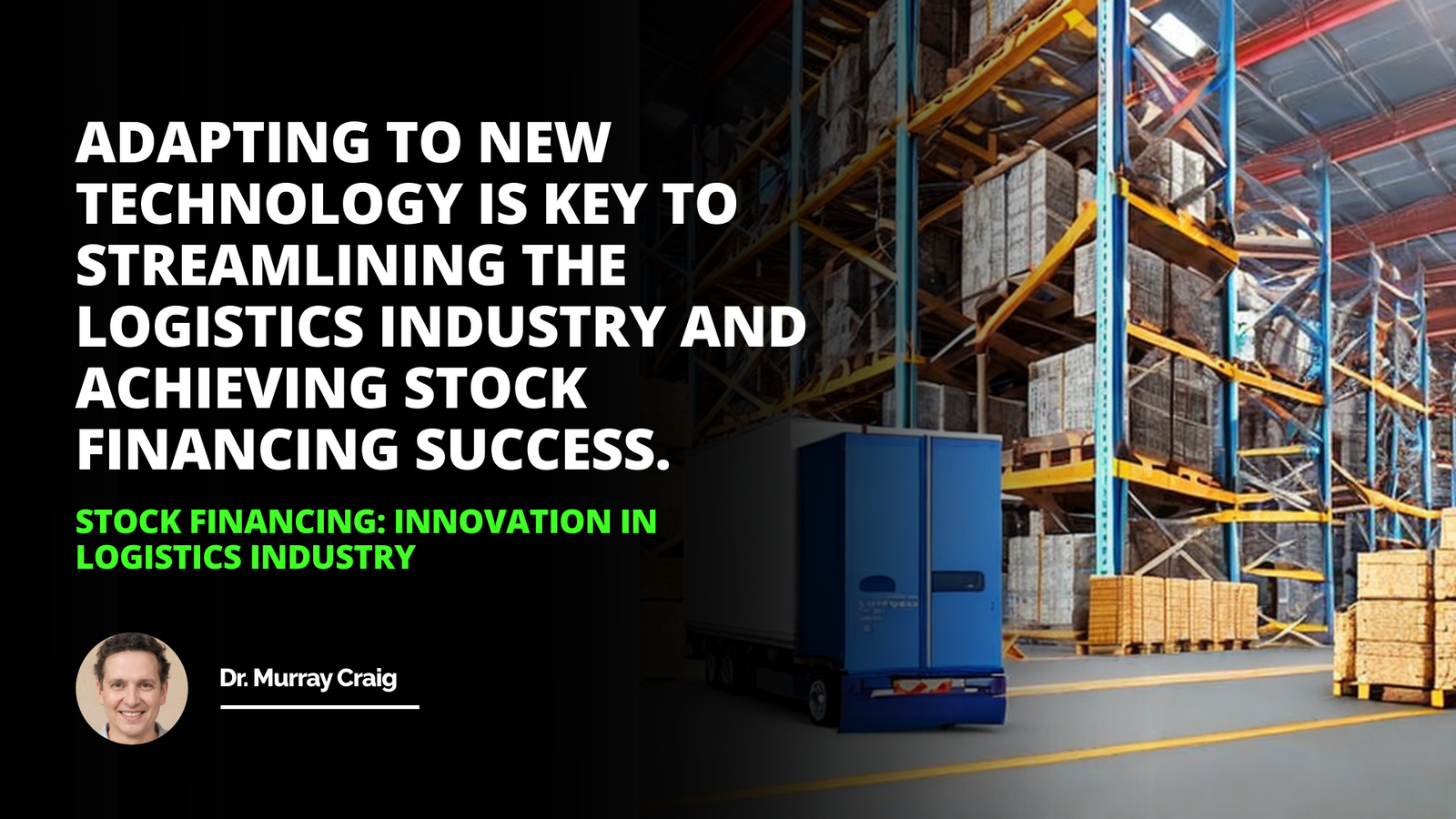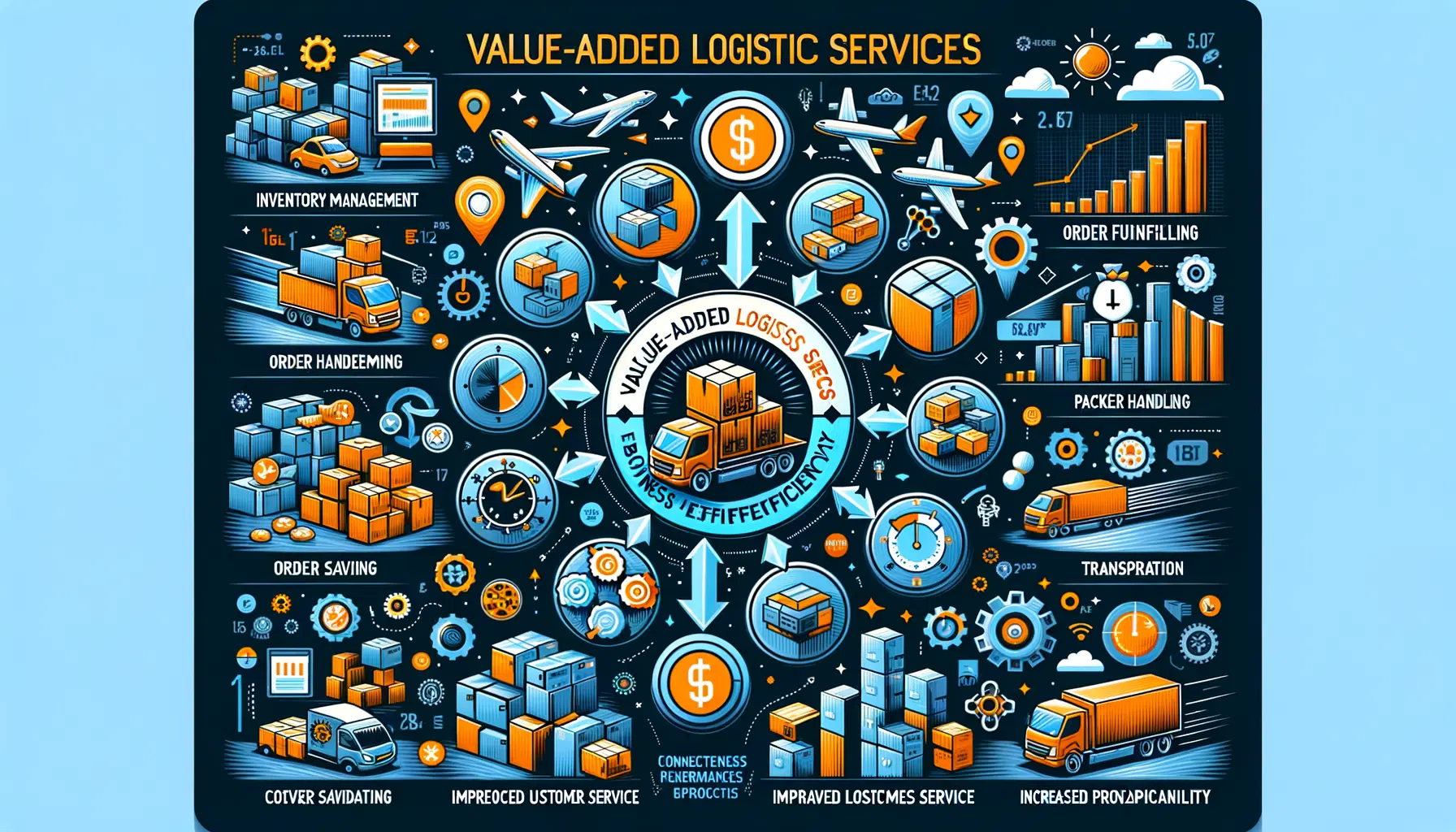
In today's dynamic and ever-evolving business landscape, companies are constantly seeking innovative ways to gain a competitive edge and streamline their operations. One crucial aspect that has gained significant attention in recent years is the concept of value-added logistics services. These services go beyond the traditional scope of logistics, offering a comprehensive suite of solutions that not only optimize supply chain efficiency but also enhance customer satisfaction and drive business growth.
At its core, value-added logistics services represent a paradigm shift in the way businesses approach their supply chain management. Traditionally, logistics focused primarily on the basic functions of transportation, storage, and distribution. However, as customer expectations have risen and market competition has intensified, companies have recognized the need for a more holistic approach to logistics. This is where value-added services come into play, offering a range of additional offerings that are carefully designed to add significant value to the end product and improve the overall customer experience.
Explanation of Value-added Logistics Services
To fully grasp the concept of value-added logistics services, it is essential to understand the key differences between traditional logistics and this evolved approach. While traditional logistics primarily deal with the physical movement and storage of goods, value-added services encompass a wide array of functions that are seamlessly integrated into the supply chain. These services can include activities such as packaging, assembly, quality control, customization, and even post-sale support. By incorporating these value-added elements, logistics providers become an integral part of the product life cycle, working closely with customers to align their operations with specific business requirements and customer needs.
Differences between Traditional and Value-added Logistics Services
Examples of Various Types of Value-added Logistics Services
The benefits of implementing value-added logistics services are manifold. Firstly, these services have a profound impact on operational efficiency and cost savings. By streamlining processes and reducing the number of handling stages, companies can significantly lower their transportation costs and minimize the risk of damage or loss. Moreover, value-added services often incorporate advanced technologies such as real-time tracking and inventory management systems, enabling businesses to accurately predict demand, optimize stock levels, and reduce holding costs associated with excess inventory.
Increased Efficiency and Cost-savings
Another key advantage of value-added logistics services is their ability to enhance customer satisfaction. In today's highly competitive market, meeting customer expectations is no longer sufficient; companies must strive to exceed them. Value-added services allow businesses to offer personalized and tailored solutions to their customers, such as customized packaging, expedited delivery options, and proactive communication channels. By going the extra mile to cater to individual customer preferences, companies can foster long-term loyalty, encourage repeat business, and differentiate themselves from their competitors.
Enhanced Customer Satisfaction
However, implementing value-added logistics services is not without its challenges. One significant hurdle is the increased complexity that comes with offering a wide range of specialized services. Companies must strike a delicate balance between providing comprehensive value-added solutions and maintaining operational efficiency. This requires careful planning, robust systems, and a highly skilled workforce capable of managing the intricacies of these services.
İmpact Of Autonomous Delivery Systems On Supply Chain Efficiency
Exploring Modal Choice Decisions Sensitivity Analysis Impact Factors
Increased Complexity in Operations
Another challenge lies in the need for advanced technology and trained personnel. As logistics processes become more sophisticated, companies must invest in cutting-edge software, equipment, and infrastructure to support their value-added offerings. Additionally, there is a growing demand for professionals with specialized skills and knowledge in logistics management. To bridge this gap, many institutions now offer comprehensive training programs and online courses that equip individuals with the necessary expertise to navigate the complexities of value-added logistics.
Need for Advanced Technology and Trained Personnel
Financial considerations also play a crucial role in the implementation of value-added logistics services. The initial investment in technology, staff training, and process redesign can be substantial, particularly for smaller businesses. Companies must carefully assess the long-term benefits and conduct thorough cost-benefit analyses to determine whether the value derived from these services justifies the investment. It is essential to have a clear understanding of the return on investment (ROI) and the potential impact on the bottom line before embarking on a value-added logistics journey.
Investment and Cost-related Considerations
Looking towards the future, the landscape of value-added logistics services is poised for significant transformation, driven by technological advancements and evolving market trends. Cutting-edge technologies such as Artificial Intelligence (AI), Machine Learning, and the Internet of Things (IoT) are expected to revolutionize the way logistics operations are conducted. These technologies will enable companies to leverage predictive analytics, automate routine tasks, and provide highly personalized services to their customers. The integration of these advanced tools will not only enhance operational efficiency but also unlock new possibilities for service differentiation and customer engagement.
Technological Advancements and Their Impact
Market Trends Influencing Value-added Logistics Services
Moreover, shifting market trends and consumer expectations are shaping the future of value-added logistics services. The rise of e-commerce and the growing demand for same-day delivery, sustainable practices, and supply chain transparency are just a few examples of the factors that are redefining the logistics industry. Companies that can adapt to these changing dynamics and incorporate relevant value-added services into their offerings will be well-positioned to meet the evolving needs of their customers and maintain a competitive edge in the market.
To illustrate the potential impact of value-added logistics services, let us consider a real-world example. Suppose a company specializing in consumer electronics decides to implement a customization service as part of its logistics operations. By allowing customers to personalize their products during the distribution process, the company can offer a unique and differentiated experience. This could involve engraving names or adding special features based on individual preferences. By integrating this value-added service, the company can reduce the time to market, minimize inventory holding costs, and create a strong emotional connection with its customers, ultimately leading to increased brand loyalty and sales.
However, implementing such a customization service is not without its challenges. The company must invest in specialized equipment, train its staff to handle the customization process, and ensure seamless integration with its existing logistics operations. Additionally, there may be concerns around quality control and the potential for delays in the delivery process. To mitigate these risks, the company must carefully plan and test the implementation, establish robust quality assurance procedures, and communicate clearly with customers about the expected timelines and any potential limitations.
Despite the challenges, the benefits of implementing value-added logistics services far outweigh the obstacles. By embracing these services, companies can differentiate themselves in a crowded market, improve customer satisfaction, and drive long-term business growth. As the famous management consultant and author Peter Drucker once said, "The best way to predict the future is to create it." By proactively adopting value-added logistics services, companies can shape their own future and position themselves for success in an increasingly competitive and dynamic business environment.
In conclusion, value-added logistics services represent a transformative approach to supply chain management, offering companies a powerful tool to optimize operations, enhance customer experiences, and achieve sustainable growth. While the implementation process may present challenges, the potential benefits are immense. As technology continues to advance and market demands evolve, the future of value-added logistics services looks bright, promising even greater opportunities for innovation and differentiation. Companies that embrace this paradigm shift and invest in the necessary resources and capabilities will be well-equipped to navigate the complexities of the modern business landscape and emerge as leaders in their respective industries.
References:
1- Christopher, M. (2016). Logistics and Supply Chain Management (5th ed.). Pearson Education Limited.
2- Langley, C. J., & Capgemini. (2021). 2021 Third-Party Logistics Study: The State of Logistics Outsourcing. Capgemini Consulting.
3- Mangan, J., & Lalwani, C. (2016). Global Logistics and Supply Chain Management (3rd ed.). John Wiley & Sons.
4- Mentzer, J. T., Myers, M. B., & Stank, T. P. (Eds.). (2007). Handbook of Global Supply Chain Management. Sage Publications.
5- Richards, G. (2014). Warehouse Management: A Complete Guide to Improving Efficiency and Minimizing Costs in the Modern Warehouse (2nd ed.). Kogan Page.
Frequently Asked Questions
What are the key indicators for assessing the impact of value-added logistics services on business efficiency?
Assessing the Impact of Value-Added Logistics
Business efficiency rests on multiple pillars. Value-added logistics (VAL) enhances these pillars. It modifies and customizes products closer to consumer demand. VAL services add immense value beyond standard logistics offerings. They include packaging, assembly, labeling, and inventory management. Assessing their impact on business efficiency involves several key indicators.
Time Efficiency Metrics
Speed is crucial. Faster order fulfillment reflects high efficiency. Track the time from order placement to delivery. A shortened duration signals VAL effectiveness. Measure the time spent on inventory management. Reduced hours indicate streamlining from VAL interventions.
Cost Efficiency Indicators
Lower costs bolster business prosperity. Examine the total logistics expenditures. Notice differences after implementing VAL solutions. Analyze the costs of returns and exchanges. Improved processes should diminish these costs. Scrutinize storage and warehousing expenses. Efficient inventory management curtails these outlays.
Quality Improvement Signs
Quality enhancements speak volumes. Inspect product condition upon delivery. Fewer damages or defects point to careful handling. Study customer feedback on product presentation. Positive comments suggest professional packaging and customization. Review handling and storage procedures. Enhanced methods reduce the risk of product spoilage.
Customer Satisfaction Metrics
Customer happiness guides business success. Survey customers for their satisfaction levels. Higher scores are often a result of VAL services. Track repeat business ratios. Loyal customers are a consequence of enhanced service. Observe the rate of customer complaints. A decline in grievances underscores improved satisfaction through VAL.
Order Accuracy Rates
Mistakes in orders deplete efficiency. Tally the error rates in order processing. High accuracy means VAL is working well. Check for correct product customization. It evidences meticulous VAL activities. Monitor the precise execution of special instructions. Accuracy here boosts overall business performance.
Inventory Turnover Ratios
Fast-moving inventory indicates good health. Calculate inventory turnover rates. Higher ratios point to efficient stock management. Assess the reduction in dead stock. It reflects accurately anticipated demand through VAL. Appraise the levels of buffer stock. Minimized buffer levels suggest better demand forecasting.
Flexibility and Responsiveness
Adaptability is a competitive edge. Evaluate response times to market changes. Swift adaptation implies robust VAL services. Measure the ability to handle special or rush orders. This flexibility often results from effective VAL strategies. Review adjustments to product varieties. Successful adaptations signal responsive VAL operations.
In conclusion, these indicators offer a comprehensive view of VAL's influence on business efficiency. Effective VAL services enhance efficiency by tightening timelines, slashing costs, lifting quality, delighting customers, reducing errors, catalyzing inventory movement, and flexing with market demands. Businesses that meticulously track these facets can better gauge the fruits of their investments in value-added logistics.
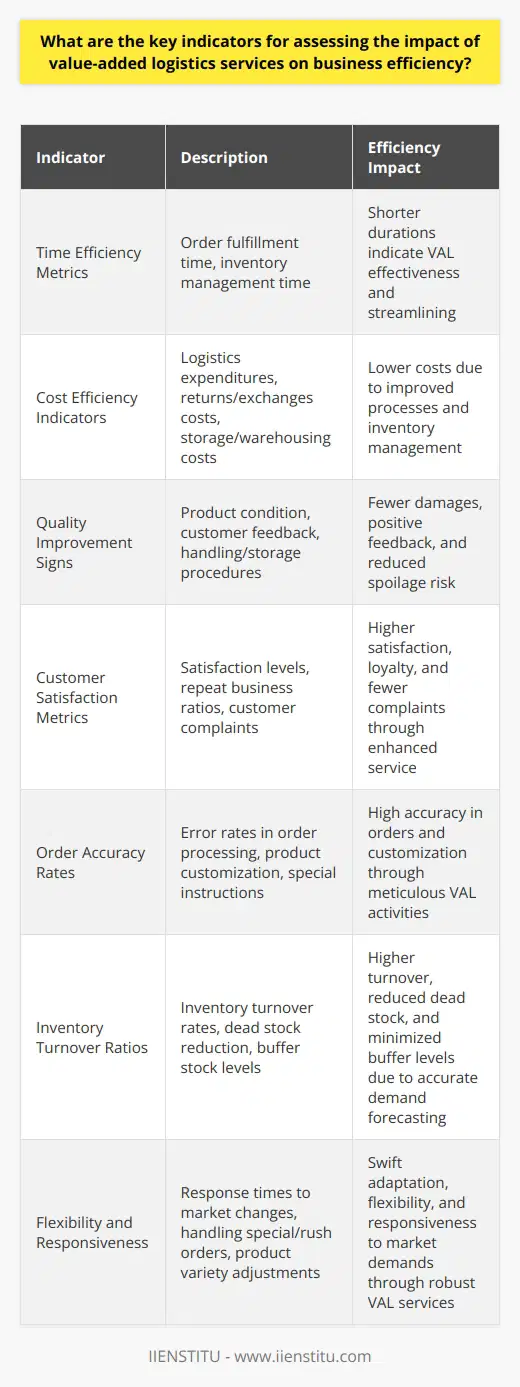
How can value-added logistics services contribute to enhancing overall business performance and competitiveness?
The Role of Value-Added Logistics
Logistics form the backbone of supply chain management. They involve the efficient transfer of goods from origin to destination. Yet, modern markets demand more. Firms now extend services beyond conventional boundaries. Value-added logistics services (VALS) have emerged. These services enhance customer experience and optimize performance.
Boosting Efficiency and Reducing Costs
Efficient allocation of resources stands paramount. VALS prioritize this. They enable companies to streamline operations. They ensure resources target the most beneficial areas. Wastage decreases. Costs follow suit.
Customization adds a layer of complexity. It demands agility in the logistics chain. VALS provide this. They facilitate bespoke product modifications. These occur near the final destination. Such adaptations require fewer movements. Efficiency improves as a result.
Enhancing Customer Satisfaction
Personalization fosters customer loyalty. VALS enable this. They cater to individual preferences. This alignment increases perceived value. Customer satisfaction rises. Repeat business often follows.
Timely delivery is critical. Expedited shipping options exist within VALS. They guarantee faster delivery. Customer loyalty grows with reliability.
Fostering Innovation
VALS encourage creative solutions. These services test the limits of logistics. They demand innovation in handling, packaging, and delivery. Businesses that innovate differentiate themselves. They stand out from competitors. Markets reward such innovation with growth opportunities.
Improving Flexibility and Adaptability
Dynamic markets require flexibility. VALS offer just that. They allow firms to adjust offerings swiftly. Seasonal demand spikes become manageable. Organizations maintain service levels, regardless of fluctuation.
Increasing Competitive Advantage
Competitive advantage stems from added value. VALS provide this by enhancing the core product. They allow firms to surpass the basic expectations of logistics. Businesses offering VALS distinguish themselves. They compete not just on price, but on value.
Quicker response times
Improved product quality
Tailored services
These perks create a robust business profile.
Value-added logistics services act as a catalyst. They propel business performance forward. They differentiate offerings in competitive markets. VALS turn logistics into a strategic asset. Firms that leverage them position themselves for success. They navigate market complexities with greater ease. Their edge? A robust, customer-focused, and efficient logistics service.
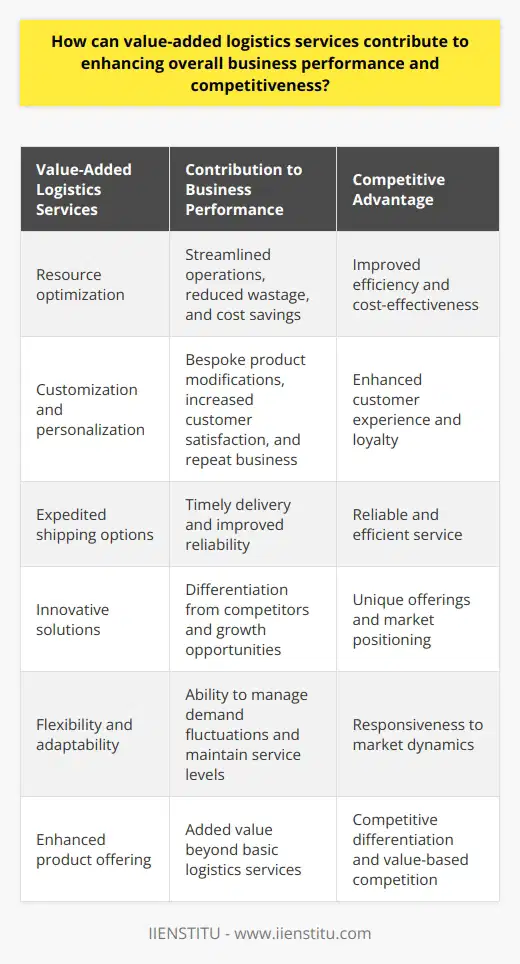
In what ways does the integration of value-added logistics services affect the operational efficiency and customer service quality of businesses?
Value-Added Logistics Services Enhance Operational Efficiency
Businesses constantly strive for improved operational efficiency. Value-added logistics services play a critical role. These services stretch beyond mere transportation and storage. They include packaging, labeling, assembly, and inventory management. Integrating these can streamline business operations dramatically.
Efficiency surfaces as reduced operational redundancies. Businesses can outsource complex logistics processes. This outsourcing allows them to focus on core activities. Simplified operations reduce the need for extensive coordination. Businesses gain from increased speed in product handling. They also benefit from optimized inventory levels. Automation becomes a game changer. It enables faster and error-free procedures.
Inventory accuracy is a direct benefit of such integration. With real-time tracking, businesses maintain tighter control. They reduce the risk of stockouts and overstock situations. These improvements lead to a leaner supply chain. A lean supply chain minimizes waste. It also reduces costs across the board.
Streamlining Task Management
Incorporating value-added services leads to clear task management. Service providers often employ advanced software and technologies. These tools aid in managing tasks effectively. Companies can track the progression of each task. They can also monitor the performance of their logistics provider. Streamlining these tasks leads to better resource utilization.
Process standardization becomes a critical aspect. Standard procedures ensure consistency. They also guarantee quality across different operations. This standardization allows for more predictable outcomes. It lays the foundation for continuous improvement.
Impact on Customer Service Quality
Customer expectations continue to climb. They demand faster and more reliable services. Value-added logistics services meet these demands. They offer specialized packaging and timely delivery. Customized logistics solutions cater to customer needs. This level of personalization enhances the customer experience.
Reliable delivery schedules are a benefit customers cherish. Value-added services include precise tracking and scheduling. As a result, customers receive their orders when they expect them. This reliability builds customer trust. It fosters loyalty.
Handling returns and exchanges becomes less of a hassle. Value-added services can manage these operations smoothly. They reduce the inconvenience for the customer. Efficient reverse logistics ensure customer satisfaction. They maintain the brand’s reputation.
Enhancing Responsiveness
Quick and appropriate responses to customer concerns mark a premium service. Value-added logistics services facilitate this responsiveness. They do so by keeping a closer connection with the customer's needs. This closer connection leads to proactive service management.
A company's agility to respond to market changes is crucial. Value-added services support this agility. They do so by providing flexible and adaptive logistics operations. This flexibility supports businesses in scaling up or down. It helps them react to seasonal demands or market trends.
The integration of value-added logistics services transforms businesses. It does so by boosting operational efficiency and customer service quality. These services streamline logistics processes. They provide consistency and reliability. They also drive down costs while increasing customer satisfaction. As customer expectations evolve, these services will play a pivotal role. They will ensure that businesses maintain a competitive edge in an ever-changing market.
